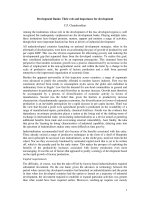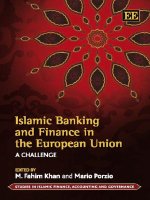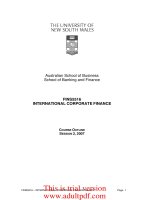Islamic Banking and Finance: History Development ppt
Bạn đang xem bản rút gọn của tài liệu. Xem và tải ngay bản đầy đủ của tài liệu tại đây (2.4 MB, 51 trang )
Islamic Banking and
Finance:
History Development
2. Islamic Banking
and Finance:
History and
Development
Some Issues
History Of IBF
Development of IBF
-Overview-
History and
Development of IBF
in Bahrain
Full Fledged IB vs. IB windows
Slide #1
• Word ‘bank’ comes from the word
‘banco’
- A table or a bench on which Italian
money-changers used to display their
monies and records and conduct their
transactions
History of Islamic Banking and
Finance
• Arabic financial and economic system pre-
Islam
– Trading based arrangements were
common
• Bay’ al-musawamah (bargaining)
• Bay’ al-muzayadah (auctioning)
• Bay’ al-amanah (trust sale)
– Al-murabahah (resale with profit)
– Al-tawliyyah (resale at cost)
– Al-wadiah (resale at loss or below
cost)
History of IBAF- (2)
– Barter trade was common
– Al-sarf (money exchange)
• Lack of standardization – for e.g., 10 grams of
gold in coin form = 15 grams of gold in bracelet
form
– Institutionalization of riba
– Widespread gharar and maysir
– Monopoly, fraud and economic injustice was
common
History of IBAF- (3)
• With the advent of Islam,
– Eradication of riba institutions and practices
– Eradication of gharar transactions
– Institutionalization of fair and equitable markets
• No monopoly, fraud
• Standardization of money and commodity exchanges
– Hadith on the six commodities
– Islamization of many business organizations and
institutions
• Mudarabah, musyarakah, salam, muzara’ah
(sharecropping or partnership in agriculture),
musaqah (irrigation)
– New organizations and institutions were introduced
• Zakah, waqf and manihah
• Baitul-mal
The first attempt to establish IB was in the
1950’s – in the rural area of Pakistan
-Pious landowners deposits their funds
without interest rewards
-Credit was advanced to other poorer
landowners for agricultural improvements
-Although there was no shortage of
borrowers, for the depositors, it was a once
and for all effort
-Depositors took considerable interest on
how the money was loaned out.
•25
th
July 1963 – February 1967
Mit ghamr Islamic Savings Bank started
in Egypt by El-Naggar
-Based on German saving bank
-Purpose to mobilize the idle savings of
the majority of Muslim within the Syariah
and to provide halal returns on their
saving as well.
-El-Naggar was an academic himself
-Managed the staff
The role of the bank (El-Naggar,
1974)
a) An efficient intermediary between the
supply and demand of capital
b) Act as one educational centre for
economic efficiency, saving education and
banking habit, and
c) Set a dynamic factor in mobilizing the idle
capital for investment, reducing hoarding
and the problem of capital formation
the Number of Depositors and Their
Average Deposits in Mit-Ghamr Islamic
Saving banks
Year
No. of
Depositors
Growth in
%
Average Deposit
Per Saver
Growth in
%
1964 17560
-
2.33
-
1965 30404 73 6.29 170
1966 151998 400 5.79 -1
1967 251152 65 7.28 26
Mit-Ghamr Islamic savings Bank's branches
Between 1963-1967
Branch Name Opening Date
1. Mit Ghamr 5/7/1963
2. Sharbine 14/08/1965
3. Al-Monsoura 11/9/1965
4. Dakerous 9/10/1965
5. KasrnAl Ayni 14/10/1965
6. Zefti 9/2/1966
7. Al-Mahallah 24/07/1966
8. Misr Al-Jadidah 23/07/1966
9. Belqaa 1/10/1966
Position of some Islamic Banks
among the Top 100 Arab Banks
Year KFH FIBE QIB DIB JIB SBB RBIC
1980 94
- - - - - -
1981 68
- - - - - -
1982 51 77
- - - - -
1983 42 66
- - - - -
1984 34 47
- - - - -
1985 39 45
-
97
- - -
1986 36 43
-
87 87
-
1987 28 48
-
93 85
- -
2000 24 90 91 48 96 58
-
2001 21 95 86 48 97 54
-
2004 21
-
90 38
-
58 6
TOP ISLAMIC FINANCIAL
INSTITUTIONS
• Islamic banking and finance (IBF) is relatively new compared to
conventional banking and finance
• Earliest Islamic financial institution can be traced to a savings
institution based on profit sharing in Mit Ghamr, Egypt in 1963
• Oil boom in the 1970s triggered a rapid growth of Islamic
financial institutions
• Establishment of the first Islamic bank (Dubai Islamic Bank in
the UAE) in 1975, as well as the Islamic Development Bank
(IDB) in Saudi Arabia
• First attempt in the West to establish Islamic banking was in
Luxembourg in 1978
Islamic Banking and Finance
Today- (1)
• Islamic scholars have profound influence on the
practice of Islamic banking and finance
– No equivalence in other religions
• Muslim governments’ approach in relation to IBF
differs
– Transformation of the entire internal financial
system to Islamic
• Iran, Pakistan, Sudan
Islamic Banking and Finance
Today- (2)
– Embrace Islamic banking as a national policy concurrently
with conventional banking and finance (dual track banking)
• Bahrain, Brunei, Indonesia, Kuwait, Malaysia, Turkey,
UAE
– Neither support nor oppose Islamic banking
• Egypt, Yemen
– Actively discourage separate Islamic banking presence
• Saudi Arabia*, Oman
History of Islamic Financial
Institutions- Overview
1950’s
(Pakistan)
A small experimental Interest- Free Bank was established
in a rural area. Loans extended to other poor landowners
for agricultural improvements. This had no lasting impact.
1963-1967
(Egypt)
Mit- Ghamr established by El- Naggar.
Followed the model of German Savings Bank. Successful
but later ended due to some political reasons.
1963
(Malaysia)
Pilgrims Fund Corporation ( Tabung Haji).
Objectives: to enable Malay Muslims to save gardually to
support their expenditure during Hajj and for other
beneficial purposes.
-Started with 1281 registered members with RM46,000
(1963)
- 4 million depositors with more than USD2 billion (2004)
1971 (Egypt)
Nasser Social Bank was established as a social bank and
not as profit oriented institutions. It was to serve
the’unbankable’ low income group.
History of Islamic Financial
Institutions- Overview (2)
1975 (Jeddah,
Saudi Arabia)
IDB was established as an Inter-governmental institution
to foster the economic and social development of its
member countries.
1975 (Dubai,
UAE)
Dubai Islamic Bank was established as a first major
Islamic commercial bank. Started the series of IFIs.
1977 (Sudan)
Faisal Islamic Bank of Sudan was established.
1977 ( Egypt)
Faisal Islamic Bank of Egypt was also established.
1978 ( Jeddah,
SA)
Centre for Research in IE in KAU was established. The
first institution specilalizing in IBF.
1979 (Bahrain)
Bahrain Islamic Bank was established.
1983 (
Malaysia)
Bank Islam Malaysia Berhad was established.
History of Islamic Financial Institutions-
Overview (3) : Asia and Western Countries
1973 (
Philippines)
Philipines Amanah Bank was established. Designed to
serve the special banking needs of the Muslim
community. Not strictly and Islamic Bank as the interest-
based operations still co-exist)
1978 (
Luxembourg)
Islamic Finance House was established.
Today
(Western)
Citibank, Merill Lynch, HSBC, Barkley’s oferring Islamic
Financial services. IBBritain, Lariba (America) were
established. Some other IFIs.
1991 (Bahrain)
Recognizing the need for standards. Accounting and
Auditing organization for IFI was established.
2002 (Malaysia)
IFservices Board (IFSB) was established . Sets to and
disseminates the prudential and supervisory standards
and core principles that are in compliance of Shariah.
Today (World)
Several other IFIs were established to create, regulate
and support the emerging IFIs. i.e- International Islamic
Rating Agency (IIRA), etc.









